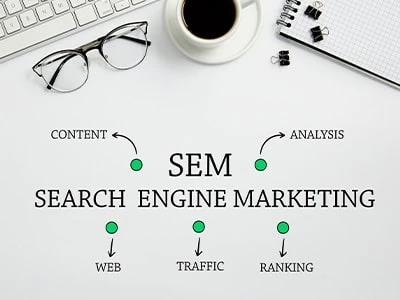Building a cool, well-known, and highly reputable brand is vital to the success of your digital marketing and vice versa. Whether you are new to marketing or have been at it for a while, there are undoubtedly countless branding terms you should know.
These key business branding and digital marketing terms help you successfully establish an online presence and help you understand the importance of key strategies. With so many marketing buzzwords and concepts out there, how do you know which are the most important?
This blog will take a look at some of the most significant digital marketing glossaries and branding terminology that marketers and advertisers use every day. Let us find out what they are.
50 Branding Terms You Must Know as a Marketer
Before launching your online reputation campaign for branding, here are the most popular and frequently used branding terms you must learn.


Branding encompasses the sophisticated techniques to intentionally mold and direct how individuals perceive and contemplate your brand. It constitutes a proactive effort to sculpt how customers perceive your brand.
Business Branding entails the discovery and articulation of your brand’s core identity through the utilization of language and visuals.
Subsequently, this fundamental essence permeates all facets of brand reinforcement, extending from promotional materials to the online presence and beyond. This unified approach cultivates trust and nurtures a profound relationship with clientele.

Your brand assets are distinctive elements crucial for etching a specific brand identity in your consumer’s perception. Your brand assets must be recognizable and work in harmony to strengthen the brand’s identity while being readily and intuitively associated with the brand itself. These valuable assets include your brand’s logo, icons, colors, fonts, and packaging.


Brand Attributes
Brand attributes are descriptive adjectives that encapsulate your organization’s identity and define the core of your organization. Brand attributes present an opportunity to set your company apart from competitors. The aim is to establish a solid footing that ensures every facet of your brand’s reinforcement, including.
- Marketing materials
- Employee attire
- Social media presence
- Accurately mirrors your organization
Furthermore, your brand attributes serve as a guiding framework for individuals who represent or communicate on behalf of your company.

A brand ambassador is someone tasked with embodying and representing your company. This individual may come from within the organization, such as an employee or executive, or they could be an external figure like a social media influencer, customer representative, or salesperson.


The perception etched into the minds of consumers engaged with your company is the brand experience. There are mainly two categories of brand experience.
- Uncontrolled brand experience involves feedback from the media and word-of-mouth communication between customers.
- Controlled brand experiences are deliberate branding efforts created on websites, in advertising efforts, through product or service usage, and within the retail environment.

Brand Extension
Your brand is inherently associated with its products or services. Therefore, your consumers identify your brand by the specific products or services it offers. Brand extension takes place when your established brand introduces a new product, either within a new category or subcategory.
Furthermore, brand extension guarantees that any novel product or service your company introduces enjoys immediate exposure by leveraging brand loyalty.


Your brand identity is the perception you project to the world about your organization. It is crucial to recognize that your brand’s character is more than just a logo.
It also encompasses various elements, including an overall aesthetic, logo, tone, etc. You create all these elements with a specific target audience and a core message in mind that you seek to convey.

Your brand image involves collective beliefs and ideas about your organization, products, and services. Once your company establishes its brand identity, consumers form their own perceptions of the products or services on offer. These consumer opinions typically reflect the current essence and standing of your brand.


Co-branding represents a marketing partnership between different product or service brands. Through co-branding, you have the opportunity to collaborate with other brands that provide products or services that harmonize effectively with the core elements of your offerings.

A brand audit is a thorough examination that assesses your brand’s standing in the market, identifies its strengths and weaknesses, and outlines strategies for enhancement.
A brand audit commences with comprehensive research on the industry, competitors, and the customer base associated with an established brand. The next step is a meticulous evaluation of the purpose, objectives, aesthetics, and overall impact of all customer-facing materials, including. enhancement.

- Logo
- Packaging
- Website
- Imagery including 2D & 3D Animations
- Social media presence
- Advertising and more
A brand audit is an effective means of identifying pain points in your customer’s journey. It also represents opportunities to enhance brand assets to better align with the overarching mission of the company.

Brand awareness is the level of recognition and familiarity a target audience has with your brand. It reflects how consumers can identify and recall your brand, its logo, or other distinctive elements.
High brand awareness is a crucial asset in marketing as it can increase consumer trust and consideration, making it more likely for people to choose that brand’s products or services.
It is an essential first step in the consumer decision-making process, as consumers are more likely to engage with and purchase from brands they are aware of and trust.

The choice of brand colors significantly influences the perception of your brand, enhancing memorability and recognition. Your brand colors have the power to attract the ideal customer base and evoke specific emotions tied to it.
When selecting brand colors, it is essential to do the following:
- Leverage color psychology
- Utilize the color wheel as a reference for creating harmonious and impactful color combinations.


Brand fonts refer to the typefaces incorporated into your visual materials and communications. When employed consistently, these fonts harmonize messaging, establish familiarity, and cultivate trust among your customers.
Just like your brand colors and logo, your chosen brand fonts should seamlessly align with your brand identity.

Brand Guidelines
Brand guidelines play a pivotal role in preserving the integrity of your logo and overall brand assets. These guidelines meticulously detail the following aspects
- The specific brand colors (along with their color codes)
- Fonts
- Logo usage guidelines
- Photography and illustration styles
- Many other distinctive design elements
Your brand guidelines guarantee that all marketing materials and communications maintain a cohesive and harmonious connection with the brand. Such consistency is a cornerstone for fostering trust between the company and its intended audience.

Brand icons are highly distinctive symbols designed for situations where space constraints make it impractical to use the primary logo, yet there’s a need for the brand mark.
For example, if you are a restaurateur, your brand icons might appear on tray liners, cups, social media profile images, marketing materials, and various other applications.
These icons have the capacity to function independently, remaining in alignment with the brand’s visual style, often incorporating the logotype for added brand recognition.

Effective brand positioning comprises three fundamental components:
1. Target Audience
Defining your brand’s intended audience is crucial. Are you catering to millennials, an older demographic, mothers, or pet owners? A well-researched brand position helps you tailor your messaging to target any type of audience.
2. Benefit
Clarify how your business enhances the lives of your target customers. What value does your product or service offer? This might range from providing peace of mind to helping them achieve their best selves.
3. Differentiator
Articulate why customers should choose your brand over the competition. Do you offer superior customer service, more convenient hours, or another unique advantage? Identifying and emphasizing these differentiators is key to effective brand positioning.

Brand Equity
Brand equity essentially signifies the value your brand holds. The greater the positive associations tied to your brand, the higher its equity. Brand equity encompasses:

- Brand Awareness and Recognition
The extent to which your brand is known and recognized by both potential and existing customers.
- Consumer Perception
Shaped by marketing efforts, customer feedback, and word of mouth.
- Customer Experience
For both first-time and repeat customers.
- Unique Selling Proposition (USP)
Your distinct qualities or differentiators.


A brand strategy is a comprehensive, enduring blueprint designed to foster the expansion of a thriving brand to attain well-defined business goals.
It influences every company facet and closely aligns with consumer desires, sentiments, and the dynamic competitive environment. Hence, it necessitates adaptability to accommodate shifting circumstances over time.

Brand support entails the continual application of strategic analysis, visual design, and content generation aimed at fortifying a brand’s presence. It encompasses a spectrum of services, such as
- Strategizing
- Web design and development
- Copywriting, digital advertising
- Social media aesthetics
- Apparel design
- Vehicle branding and more


Rebranding is the process of rejuvenating or reimagining a well-established brand, intending to reposition it. Numerous motivations drive the decision to embark on a rebranding journey, including.
- Conveying a fresh message
- Disassociating the company from unfavorable associations
- To venturing into uncharted markets.

Customer personas are semi-fictitious depictions of your perfect customers, shaped by data and research. They are pivotal in enhancing your comprehension and targeted approach to fulfilling customer requirements across various channels, encompassing marketing, sales, and customer service.

Your customer persona defines your target audience when formulating new ad campaigns or content. It encompasses the group of individuals who stand to benefit from a company’s offerings. Identifying a target audience through both paid and organic efforts is essential for increasing sales and expanding reach.

Customer touchpoints are the points of contact between your brand and its customers, encompassing a wide array of interactions. These touchpoints include but are not restricted to
- A website
- Promotional materials
- Advertising
- Email marketing
- Physical locations
- Social media and more

A tagline typically accompanies your company’s logo. It is a concise rendition of your company’s slogan that encapsulates the core essence and significance of who you are as a brand.


A descriptive paragraph elaborates on your brand positioning statement, delving further into your brand’s narrative. This paragraph serves as a clear communication channel to convey your business’s unique selling points.
It also sets expectations for what patrons can anticipate when they connect with your brand, covering everything from the products offered and service quality to the overall atmosphere.

Environmental branding, or interior branding, involves the practical implementation of harmonizing your physical space with the visual identity of your brand. It represents a potent means to accentuate your brand and craft an engaging, immersive encounter for customers and employees.

By branding key touchpoints within your physical environment, you can establish a profound, enduring rapport with customers, leaving a lasting impact from the instant they step in until they depart.

A logo is commonly characterized as an emblem or a stylized representation to distinguish your brand. However, it encompasses much more as your brand logo stands as the embodiment of your company, representing the paramount symbol linked to your business.
You can characterize a strong logo by its simplicity, adaptability, memorability, and seamless alignment with the essence of your brand.



Additional Digital Marketing Terms You Must Know
To accent your branding campaign, here are some of the most popular and valuable digital marketing terms you must know.

A/B Testing is also known as split testing. This technique involves assessing two or more variations of your digital content with a specific audience. The primary aim is to find the preferred version determined by measuring the conversion rate.
You can frequently implement it to assess e-newsletters, email subject lines, social advertisements, calls-to-action, and the copy on landing pages.
This helps you determine which version is more likely to elicit the desired action, such as signing up for a paid membership.
You can frequently implement it to assess e-newsletters, email subject lines, social advertisements, calls-to-action, and the copy on landing pages. This helps you determine which version is more likely to elicit the desired action, such as signing up for a paid membership.

An affiliate marketing strategy incentivizes individuals or organizations external to your business to attract new customers or visitors to your brand. This is accomplished through promotional activities, such as advertising or content placement on the affiliate’s website.

In exchange, you pay that organization or individual a commission determined by the number of customers they generate. This approach is a perfect fit for personal or lifestyle brands and websites for product recommendations.

The process of strategically devising and executing digital content to generate and publish content for digital marketing campaigns. Your content strategy may include:
- blog posts
- articles
- social media updates
- videos
- podcasts
- e-books
- guides
- webinars
- Whitepapers and more
This process involves testing to assess content effectiveness, as content is the foundational cornerstone upon which all marketing strategies are constructed. This digital marketing concept forms an integral part of content marketing campaigns as well.

The conversion rate percentage is the proportion of users who have successfully taken the intended action. You calculate your conversion rate by dividing the total number of “converted” users by the overall audience size. For instance, this metric applies to those who click on an advertisement.

Marketers rely on the conversion rate as a critical benchmark for enhancing future growth. In data-driven digital marketing strategies, conversion rate is one of the most prevalent parameters used to evaluate the effectiveness of any campaign.

This pricing model exclusively gives you a summary of leads, sales, or conversions that your businesses actually achieved. Your CPA represents a financial gauge that quantifies the expenses of acquiring a single-paying customer.
Cost per acquisition also helps you determine your company’s affordability to acquire leads and stimulate fresh customer acquisition.

CPC is a pricing model that gauges the cost incurred for each click on an advertisement, primarily aimed at directing traffic to your website. It serves as a vital digital marketing metric, illustrating the expenditure a business undertakes for each click on its ad.


CRM is an acronym for Customer Relationship Management. It is a suite of tools that you, as a marketer, use to oversee
- Customer data
- Scrutinize customer interactions
- Obtain up-to-the-minute pertinent information.
CRM serves as the backbone for enhancing customer relationship strategies, as well as personalizing and refining the targeting of marketing services.

A Call to Action (CTA) is an element like text, banner, form, button, or image strategically placed to encourage your website visitors to undertake a particular action. CTAs play a crucial role in guiding your customers and visitors along their purchasing journey and exert a significant influence on conversion rates.
Your CTAs can range from reading more content, joining, subscribing, signing up, or purchasing.


CTR signifies the percentage of users who click on links embedded in emails, ads, websites, and other digital platforms. It quantifies active user engagement with linked content on a site, calculated using the formula:
CTR = (click-through/impressions) x 100
Your click-through rate helps you understand customer behavior and fine-tuning target audience strategies.

Conversion Rate Optimization is a structured approach to improving your website’s performance by increasing the proportion of visitors who take the desired Call to Action (CTA). CRO functions as a marketing framework to boost the rate at which your visitors convert into paying customers.

CRO techniques allow you to foster an enhanced user experience, generate top-notch leads, and expedite the conversion of potential leads into actual customers.

This metric is particularly pivotal in social media marketing, serving as a gauge of success in terms of brand visibility, affinity, and credibility. It stands out as a potent measure of social media campaign success, especially when the primary objective is to build a robust subscriber or follower base for your social profile.

KPIs are metrics or quantitative benchmarks to monitor progress toward your marketing objectives. KPIs should adhere to the SMART criteria:
S: Specific
M: Measurable
A: Achievable
R: Relevant
T: Time-Bound

Your key performance indicators are instrumental in gauging your performance and guiding the course.



Paid ads are instrumental in generating website traffic, ensuring that marketing content gains priority placement. This category encompasses two primary types: social media and display ads, strategically targeted based on trackable behavioral metrics. They play a vital role in reaching relevant leads.

These scores are employed to assess the relevance of an advertisement and how it stacks up against similar ads on the platform. Higher scores lead to more prominent ad visibility compared to competitors. Enhancing these scores aids in reducing the Cost Per Click (CPC).


ROAS is a crucial marketing metric used to gauge the effectiveness of advertising campaigns and calculate the return on investment for paid marketing efforts, including ad expenditures. It facilitates the evaluation of the methods yielding results and provides insights for enhancing future advertising endeavors.
Search Engine Marketing strategies are devised to secure better placement on search engines by bidding on specific search terms, boosting your website’s visibility in search engine results pages. SEM primarily refers to paid search advertising and is alternately known as pay-per-click (PPC). It is instrumental in generating high-quality leads.


The sales funnel illustrates the journey from a potential lead to a paying customer. There are three key stages in your sales funnel.
Top of the Funnel
The initial phase of the buying process is when your visitors are in the early stages of seeking information. Building trust is crucial in this stage, primarily achieved through delivering high-quality content to inspire visitors to progress to the next stage.
Middle of the Funnel
In the middle stage, buyers have recognized their problem and need but are still researching to make informed decisions. At this point, leads transition from the marketing department to the sales team.
Bottom of the Funnel
The final stage is when the buyer is ready to purchase after evaluating multiple vendors. A consultative approach is pivotal in assisting the customer in arriving at a decision, ultimately sealing the deal.

